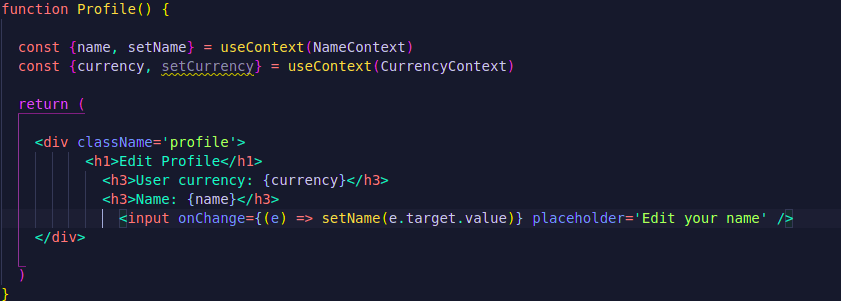React all hooks series: Let' acquire the useContext hook.

Amine Amhoume
Posted on February 1, 2022

Look! Every feature should solve a problem, so if you want to understand a new concept of a feature, then you have to figure out what problem it solves and how.
This is a journey to comprehend the problem with passing data using props and how Context API solve this problem. By the end of this tutorial will get the prize of acquiring the power of useContext hook.
Prerequisites? Basic ReactJS, know how to use useState() hook, and to understand what are props.
That's it. Let's go.
What is Context API?
Context provides a way to pass data through the component tree without having to pass props down manually at every level. We can implement it to work with global state and avoid props drilling.
Props drilling is when we are obligated to pass props to components that don't use them but their children do.
In the above picture, we are obligated to pass thename state through the Settings component as a middle man to work with it in the Profile and Shipping components ( Maybe pass it to the Appearance component too if it has children that require the state "name").
Code example?
In the Home component, we have the global state called name, consider it as a username. We pass the name andsetName to the Settings component as props and transfer them again to the Profile and Shipping components.
Let's cut the middle man by using the Context API.
First, we import createContext , initialize it with a null value, and export it :
import React, {useState, createContext} from 'react';
export const NameContext = createContext(null);
Next, we wrap the component we want to pass the data down to with a context Provider.
Keep in mind that the value prop is required. Here, we are passing an object.
Now the Settings component is clean.
"Profile" and "Shippings":
We import the NameContext we initialized before in Home , then we create a Consumer that wraps a function, the function takes an obj as a parameter ( it's the one we passed using the value prop) and return JSX with the state we want to render.
That was nice, right? I mean we cut the middle man (Settings component ). We no longer depend on it.
Our solution to props drilling is working but it's vulnerable.
Imagine if we have more that a global state to pass down the component tree.
Let's create another state called currency. User's currency in use.
const [currency, setCurrency] = useState('USD')
We initialize a context for it.
export const CurrencyContext = createContext(null);
And then, pass it by wrapping the Settings component with the currencyContext.Provider :
Let's use it in the Shipping component:
Inside the NameContext consumer, we inject the CurrencyContext consumer with a function that returns the JSX which uses the state.
It's hairy and ugly.
We need to simplify it. Let's invoke the useContext hook.
The Amazing useContext hook.
useContext is so simple to use. First, we import it:
import React, {useContext} from 'react';
Inside the Profile component, we initialize it with the name of the context as a value:
Just like that, we use it inside our JSX. No nested functions and thus no ugliness.
Congratualations, the journey has ended and you have acquired a new hook. Use it cleverly.
That was quite straight to the point, wasn't it?
See you in the next article…
Wait!
I'll be glad if you share my article.

Posted on February 1, 2022
Join Our Newsletter. No Spam, Only the good stuff.
Sign up to receive the latest update from our blog.













